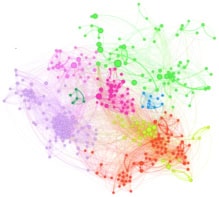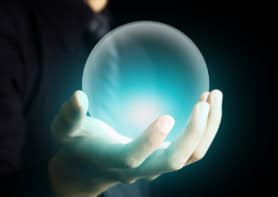Martin Zaltz Austwick reviews Social Physics: How Good Ideas Spread – the Lessons from a New Science by Alex Pentland

Alex “Sandy” Pentland is a computer scientist with an impressive academic record and an even more impressive history of translating academic outputs into business and consultancy. To say he has entrepreneurial flair would seem to be an understatement; his previous book was a bestseller, and his career is sprinkled liberally with consultancies and spin-outs from his research group. His career defies easy categorization, but he calls the work that he does on network analysis and computational social science “social physics”. In his latest book, Social Physics: How Good Ideas Spread – the Lessons from a New Science he outlines his vision of a discipline that has a history of infighting and intellectual land-grabbing.
The term “social physics” was originally coined in the early 1800s by the philosopher Auguste Comte, who hoped that a mechanistic science could help to unravel society’s complexities. When another scholar, the Belgian astronomer Adolphe Quetelet, started using the term for his own brand of mathematical social science, Comte decided he didn’t want to be a social physicist anymore and became the first sociologist instead. Whether this reflects worst on the egos and caprices of physicists or sociologists rather depends on the reader’s existing prejudices.
Since Comte’s day, attempts by political philosophers, mathematicians and computer scientists to create a definitive calculus of human society have failed in a variety of interesting ways, whether from lack of data, poverty of imagination or dogmatism of approach. The people who you might identify as social physicists nowadays would probably say they worked in complexity theory, network science, machine intelligence or another of the technically challenging, frequently data-led approaches sitting at the nexus of statistics, computational modelling and applied maths. It’s not so much a discipline as an enthusiastic club, formed largely of recovering physicists and computer scientists who take a quantitative approach to understanding people.
Pentland’s definition of social physics is certainly within this wheelhouse. His work focuses on the power of social networks – power to influence people to exercise and lose weight, to enable creativity, and to create “cities of tomorrow” in the mould of Jane Jacobs, the 20th-century journalist turned urban-studies activist. Many of Pentland’s studies are based on user-centred data, often gathered from sensors that are worn on the body and are designed to collect information about social interaction. These data include aggregate information, such as how often these individuals meet one another, but also more detailed evidence about conversational turn-taking and duration of speech.
This micro-level information is synthesized into living, breathing, second-by-second social networks in a manner unimaginable by Stanley Milgram when he carried out his field-defining “six degrees of separation” experiment nearly 50 years ago. With a little statistical magic, Pentland’s team at the Massachusetts Institute of Technology has been able to convert these rich data streams into concrete insights into the functioning of social networks, and create recommendations that have helped to transform businesses and public health projects.
While the work they’ve done is impressive and engages wonderfully with the world it seeks to improve, it feels like there are areas where Pentland’s book runs aground. The worlds of data science, “big data”, “smart cities” and the “Internet of Things” are already having huge impacts on the social sciences – sociologist Emma Uprichard referred last year to the “methodological genocide” that is being visited on her subject – and so tying “social physics” to a specific branch of network theory with an added dash of management science or social psychology seems very specific in scope.
Pentland also seems to flounder when it comes to the contentious political issues that working in social science almost inevitably generates. In particular, the ways in which he discounts the concepts of “markets” and “class” seem like a desire to sidestep the thorny issues that characterize divisions between the right and the left. He is prone to techno-Utopianism, and seems to take the view that creating and mediating social networks (perhaps via smartphones or sensing technologies) will solve the problems that plague the modern city. To support this theory, he cites Jacobs’ ideas of community urbanism (themselves partly inspired by the early discussions of complexity science by Warren Weaver), but I would have liked to have seen more of the scholarship that bridges Jacobs’ mid-20th century work and Pentland’s current research. References to this body of work are rather buried in the bibliography, and aren’t really discussed a great deal in the main text. He does, however, give special note to individuals when he discusses the work of his own PhD students – a significant gesture that I suspect many senior academics forget in the white heat of a book deal, and one that makes me rather warm to him as an author.
Some of the ideas that I found most exciting in Pentland’s work were relegated to later sections, such as his Open Personal Data Store, where users would store their personal data (not only biographical but real-time and location based) and decide who has access to it, and at what price. (For example, are the services provided by Facebook worth a certain loss of privacy? How much privacy?) This user-owned model of data could be nothing short of revolutionary. His work in analysing mobile phone data for the whole of Côte d’Ivoire is also fascinating and creates huge opportunities, as well as raising issues around globalism and inequality. This, however, is covered rather briefly.
Social Physics is an engaging and worthwhile read, and a good introduction to some of the ideas fizzing around the discipline. It focuses almost exclusively on Pentland’s own work, but does so in a readable and enthusiastic fashion. On the downside, it left me wanting to hear more of the stories behind the “thousands of hours of sensing” and “hundreds of gigabytes of data” these studies collected. We only really hear Pentland’s success stories, but what happened when things went wrong? What was unexpected? It’s these details and fallibilities that bring research stories to life. This wonderful flavour of science gives us new techniques to understand and tackle social problems, but these techniques raise their own questions – questions that are sometimes too easily dismissed in a zippy “tasting menu” that shows off Pentland’s particular flavour of social physics.
- 2014 Penguin Press $27.95hb 320pp



